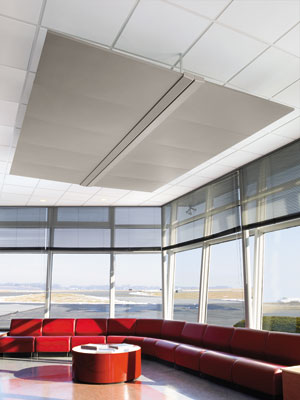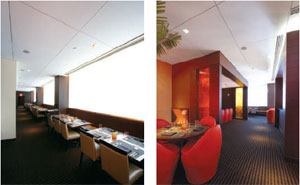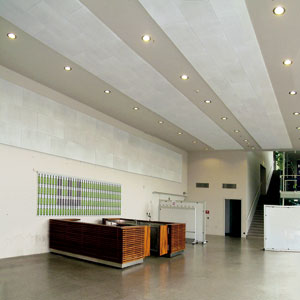|
|
New recycled acoustic product breaks free of the stereotypical glass ceiling One of the intriguing new products introduced at last month’s surprisingly busy AIA Conference & Expo in San Francisco was Phonstop ceiling and wall tile from Minneapolis-based pinta acoustic (formerly illbruck acoustic). “The response was very, very good,” says Joerg Hutmacher, business unit manager for pinta acoustic. “Of the products pinta featured at AIA, Phonstop received the most attention.” Phonstop ceiling and wall tiles are made from 100 percent post-consumer recycled glass sintered to form rigid, lightweight, and porous sound absorbers. Phonstop V tile is made for adhesive applications on walls and ceilings and offers a noise-reduction coefficient (NRC) of up to 0.90 to reduce reverberation and echo. Tiles can be adhered directly to walls and ceilings without subconstruction or wall cavity. Panels are available in 24'' x 24'' x 2'' and 24'' x 48'' x 2'' in two edge options: One face of the tiles features 3⁄8’’ chamfer beveled edges, while the reverse face has square edges. Tiles are temperature- and weather-resistant; in weather-exposed conditions they require a sealer. The tiles are available in natural gray but can be painted on-site with a nonbridging paint applied with an airless sprayer. For a seamless, monolithic look, tiles should be primed first and then followed by two layers of plaster applied before painting. Phonstop E tiles are made for ceiling grid applications and feature an NRC of up to 0.70. The natural gray tiles can be mounted in pinta acoustic’s or any standard ceiling grid system and are available in 24'' x 24'' x 1'' and 24'' x 48'' x 1'' dimensions. The product is Class A fire rated, and resistant to chemicals, moisture, mold, and impact. It is also easy to cut and drill to accommodate fixtures, and is suitable for use with antigraffiti systems. Both products can contribute to points for LEED-NC and LEED for Schools, including points for recycled content, construction waste management, innovation and design process (for acoustical properties), and indoor environmental quality. “The tiles can even be made into the same product again,” says Hutmacher, although pinta acoustic does not currently have a recycling program in place. The tiles are ideal for new and renovation projects — including, but not limited to, offices, schools, staircases, transit stations, religious facilities, and multifamily buildings. Recent installations reflect the diverse potential for the product: the lobby of a fitness center in Hollabrunn, Austria; a department store café in Hamburg, Germany; and stateside, an installation at Mortenson Construction in Minneapolis that was designed by the Minneapolis firm RSP Architects. pinta acoustics, Minneapolis. [Reader Service: June 2009 #205] |
 |
Take flight [Reader Service: June 2009 #206] |
 |
Green boost from above [Reader Service: June 2009 #207] |




Post a comment to this article
Report Abusive Comment